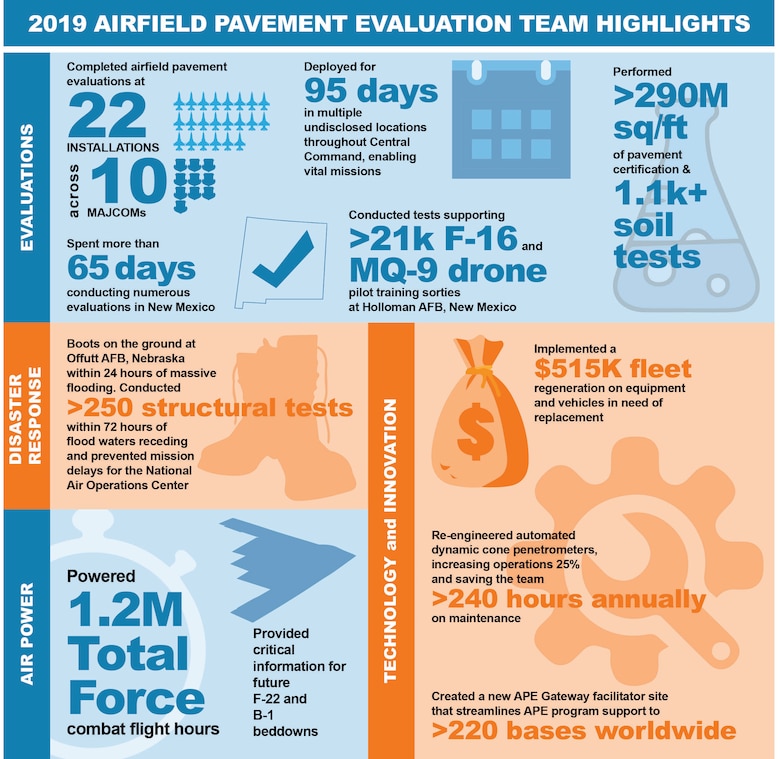It takes a lot of pavement to launch an Air Force - 2.2 billion square feet - and in 2019, a team of airfield engineers stationed at Tyndall Air Force Base set a blistering pace to ensure that pavement was able to support aircraft worldwide in flying more than 1.2 million hours.
The Air Force Civil Engineer Center's Airfield Pavement Evaluation team set the milestone while supporting not only typical flight operations around the world, but also in response to three natural disasters, including Hurricane Michael, a hurricane that slammed into Tyndall AFB in 2018.
The team evaluates and ensures the viability of more than 200 airfields around the globe, looking at everything from surface conditions to risk of foreign object damage, said Capt. Ben Johnson, APE branch chief.
"We're the Air Force's only asset for full-spectrum pavement evaluation and have deployable teams that can go worldwide on short notice," Johnson said. "We conduct comprehensive evaluations at our main operating bases every 10 to 12 years and … we surge to support operations in the combat theater and emergencies wherever they may occur."
The APE team's flexibility and surge capabilities were tested in 2018, he said. A week after Hurricane Michael, a historic Category 5 storm, devastated Panama City, APE was on the scene to make sure the Tyndall AFB runway was structurally capable to support inbound aircraft bringing rescue supplies and ensure the Air Force mission was able to continue.
Less than two months later, the APE team went to Joint-Base Elmendorf-Richardson, Alaska, after back-to-back earthquakes damaged the installation. The team then deployed to Offutt AFB, Nebraska, where extensive flooding from the Platte River overwhelmed 30 buildings and approximately 3,000 feet of runway.
The APE team was in the midst of an evaluation at Cannon AFB, New Mexico, when they received the evaluation request from Offutt AFB. Johnson said they paused their work at Cannon AFB and immediately drove to Offutt AFB, arriving less than 72 hours after receiving the call.
"We were able to make a quick turn, divert over there and start evaluating right as the flood waters receded," Johnson said. "We were able to give them an answer in about three days as to whether it was safe to operate aircraft on that previously flooded pavement. A good bit of the airfield was submerged."
More recently, an APE team comprised of Johnson, Master Sgt. Jill Reed and Tech. Sgt. Nikita Kraev deployed to the Air Forces Central Command area of responsibility with their support vehicles and equipment on less than five weeks' notice.
"They just spent the last four months evaluating multiple airfields in the Middle East on behalf of Air Forces Central Command and emergency security requirements," said Col. John Tryon, AFCEC's Operations Directorate director and senior leader for the APE team. "Nobody else in the Department of Defense can provide this level of detailed, responsive airfield structural analysis for the warfighter."
In the midst of completing evaluations at 22 installations across 10 major commands in 2019, Johnson said the team also identified opportunities to improve safety, increase operations by 25% and saved more than 240 hours of annual maintenance by replacing their outdated trucks.
"This is such a great team, and these young Airmen are among the brightest CE officers and engineer assistants that we have in the Air Force," Tryon said.

The Air Force Civil Engineer Center's Airfield Pavement Evaluation team ensures mission-ready airfields. The team evaluates and ensures the viability of more than 200 airfields around the globe, looking at everything from surface conditions to risk of foreign object damage. (U.S. Air Force graphic by Jim Martinez)






